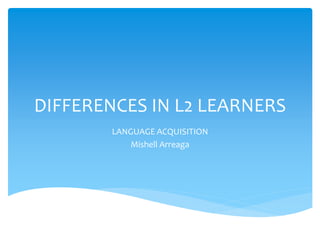
L.a.1.4.language.acquisition.mishell.arreaga
- 1. DIFFERENCES IN L2 LEARNERS LANGUAGE ACQUISITION Mishell Arreaga
- 2. YOUNG LEARNERS OLDER LEARNERS The young learner`s brain is like a sponge which absorbs and processes new information quickly and easily. Limited learning capacity because of brain maturation. The young learner likes to interact with others; the learner receives a great amount of language input. The adult learner does not look for interactive communication so he receives poor language input. The young learner`s memory is phenomenal; it retains easily a lot of information. The adult learner`s memory elasticity decreases and it becomes more difficult to retain information easy. The young learner acquires a native-like language knowledge by being exposed to real life situations. The adult learner is more likely to develop a foreign accent and to be grammatically less natural. AGE
- 3. BOYS GIRLS Boys learn better a language by seeing using visual aids. Girls tends to be better in grammar and spelling. Boys are better in understanding and figuring out compositional rules. The girls` brain shows more activity when learning a language. Boys automatize language skills better and giving place to an affective language learning. Girls are good in remembering difficult linguistic forms. Boys acquire language through its sensory system. Girls are semantically and verbally more competent. SEX
- 4. Being apt to learn a language consists on: 1. phonemic coding ability: being capable to decode incoming speech sounds. 2. inductive language learning ability: being capable to figure out how the rules governing the language work. 3. grammatical sensitivity: knowing the function of each linguistic element. 4. associative memory capacity: to be able to memorize linguistic forms accurately and to use them appropriately. APTITUDE
- 5. A feeling of determination to achieve some desired goal; there are two types of motivation: Integrative motivation: the learner acquires the second language because he desires to fit in a society where the L2 is spoken. Instrumental motivation: the learner acquires a second language because he needs it to fulfil another goal like having better job opportunities, for graduating, or for traveling. MOTIVATION
- 6. A certain manner of perceiving and processing information; there are different cognitive styles: COGNITIVE STYLE Field-independent: recognize objects no matter the complexity of the background. Field-dependent: the field should be clear, if not, things are not perceived easily. Global: capable of perceiving things as a whole. Particular: individuals considers specific things for information processing. Holistic: individual looks for the general idea of something. Analytic: capable to analyse each detail within a context. Deductive: the learner discovers the rules governing the L2 by themselves. Inductive: the learner prefers to analyse the rules governing the L2 to learn it. Focus on meaning: special attention is given on learning the meaning of the L2. Focus on form: a predisposition on learning forms and features of the L2.
- 7. Some types of personalities seem to provide better language learning results like: imaginative, creative, empathetic and tolerant. Anxious learners are predisposed to have language learning issues which is caused by having a low self-confidence. Extrovert personalities are always interacting which is important during language learning; introvert personalities are effective language learners. Inner-directed/other-directed and reflective/impulsive personalities are not really factors that influence positively nor negatively the learning process of the learner. Shy versus adventuresome; shy personalities may not enjoy language learning as an adventuresome learner would do; they may do it better in learning. PERSONALITY
- 8. METACOGNITIVE COGNITIVE SOCIAL/AFFECTIVE Strategies consisting on preparing the learners on what they are going to expect during the lesson. Strategies which consist on brainstorming; mind mapping; scanning; summarizing; such activities promote language learning. Such strategies demands to the learner to be interactive; to ask questions; to give comments; on the part of the teacher to give feedback or washback. LEARNING STRATEGIES Methods implied on teaching a subject depending on the learning style; personality and motivation of the learner.